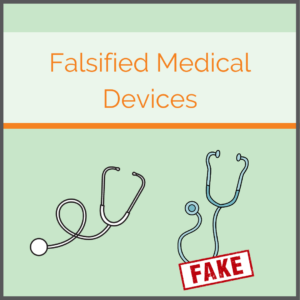
Counterfeit medical devices are a problem worldwide, as inferior counterfeits endanger patients’ lives. Unlike counterfeit medicines, however, there is hardly any data or established processes and regulations to help solve the problem.
Medical devices form a diverse and large group with over 500,000 products. Subsequently, they are often affected by counterfeiting or irregularly removed from the supply chain. However, there are no standardized processes for reporting or data collection on the part of the European authorities. There is a considerable need to catch up, particularly regarding data collection and information dissemination. In addition, there is a lack of visibility for stakeholders along the supply chain. Counterfeiting or the irregular removal of medical devices from the supply chain is also not consistently prosecuted. At the same time, we are in a phase of innovation, including rapid development in AI, so the issue is becoming increasingly relevant.
The status of medical device counterfeiting in the EU
A recent survey by the Committee of Experts on Minimizing Public Health Risks Posed by Falsification of Medical Products and Similar Crimes (CD-P-PH/CMED) focused on this topic. The competent authorities of the EU member states were asked how they view the issue of falsified medical devices and what measures they are taking.
The most important results:
- It is difficult for the authorities to identify counterfeits, as there are numerous players involved along the supply chain who could potentially recognize counterfeits. In most cases, there is also a lack of experience.
- Most authorities do not provide official processes or tools, such as checklists, for customs or health experts to identify counterfeits more easily.
- More data exchange between authorities and supply chain actors is generally considered useful.
- Although it is mandatory to report (suspected) cases in most countries, there are only a few countries with a dedicated reporting office.
- At the time of the survey, one in 19 participants was aware of the knowx.edqm.eu reporting office, an official European platform that enables the various stakeholders to inform each other about counterfeiting and exchange information.
- The respondents considered awareness of the existence of counterfeit medical devices among users (healthcare professionals, patients) to be quite low.
Although the MDR regulates several points relating to counterfeit medical devices, the survey found that it is still too early to recognize any effect on handling counterfeits. Also, it is criticized that the MDR has not yet been implemented to its full potential. One part of this criticism is that the use of EUDAMED is not yet mandatory.
The following articles in the MDR regulate the handling of falsified medical devices:
- Article 2 (9) defines falsified devices,
- Article 7 sets out prohibited false impression claims (i.e., claims that may suggest a product is a medical device when it is not),
- Articles 13 and 14 give reporting obligations for importers and distributors for falsified devices, respectively; and
- Article 93 gives competent authorities the right to take falsified devices off the market to protect public health.
Examples of counterfeit medical devices
LifeVac (UK) produces a medical device that helps to clear physically blocked airways. On their website, they actively provide information about counterfeits of their product in circulation and why they are so dangerous. In this example, it is a product that can save lives in acute cases. This shows how important it is to act against counterfeits. LifeVac demonstrates that the lack of control and testing of the product means its functionality is not guaranteed. For example, they are working also in extreme temperatures, putting lives at risk due to counterfeiting.
The issue also became particularly apparent during the coronavirus pandemic. Even at the beginning of 2020, the WHO warned against counterfeit medical devices and medicines, such as test kits or vaccine doses, which were spreading rapidly on the market.
What solutions are there for detecting counterfeit medical devices?
EUDAMED offers the potential to detect counterfeits more quickly. All relevant data is stored here for comparison with the product. Central management and public access to the data can, therefore, have a beneficial effect on the detection and tracing of counterfeit medical devices. Everyone who uses a medical device can compare the data on the packaging, for example, the UDI, via EUDAMED.
In addition to the mandatory information, some manufacturers also use an additional product identifier, a serial number. This is one of the permitted but voluntary features under the MDR. Serial numbers could make it easier to identify counterfeits or originals.
Strengthening post-market surveillance is one of the objectives of the MDR. Retailers should take responsibility here and contribute to the fight against counterfeit medical devices by acting proactively.
As the survey of the authorities shows, data collection, information exchange, and awareness-raising are seen as the main levers for combating counterfeit medical devices.